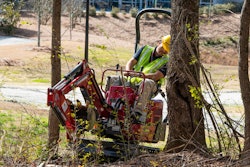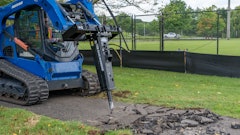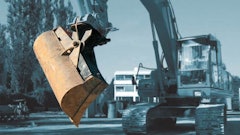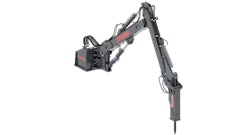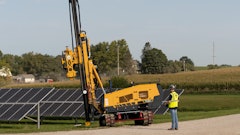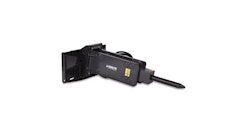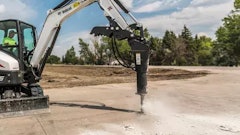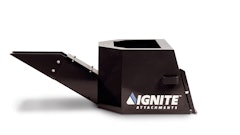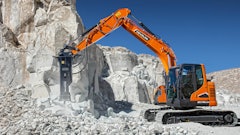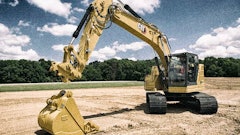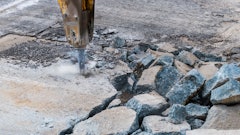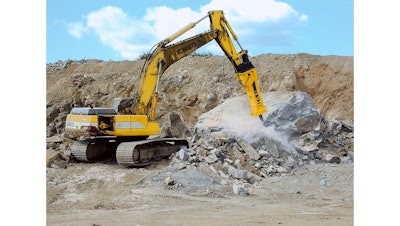
Manufacturers offer plenty of instruction for operating their hydraulic breakers but their intense forces, range of materials broken, work conditions and carrier machines chosen make production without sacrificing attachment’s life as much finesse as it is science.
Any machine built to hit hard enough to break granite boulders will be hard on itself and anything connected to it. Even when they’re used as designed, they create punishing levels of vibration, dust and heat. Your excavator or loader’s hydraulic system is subject to those conditions too.
Tips in the operator’s manual are correct, but the difference between a job well done and misuse that accelerates the self-destruction of two machines can be a matter of inches.
1. Position and Reposition the Breaker
Setting the moil point in the middle of a big chunk of concrete or boulder usually invokes the classic breaker double-whammy – it’s not only less productive, but it’s also harder on the machines.
Operators need to get good at looking for cracks they can take advantage of, particularly near the edges of objects they’re trying to break. Position the tool at a 90-degree angle to the work surface, lean some of the carrier’s weight on the tool point and hit it with short bursts. If the material breaks, move the tool inward. If the target doesn’t break, reposition the breaker laterally and try another spot closer to the edge. Scoring along an edge can get the job done. With repositioning between short bursts as the watchword, the tool should be moving frequently.
After 15 to 30 seconds of hammering without penetration on one spot you’re no longer breaking, you’re trying to drill – not what breakers are made for. It can generate a lot of dust and heat (there’s a reason recommended breaker grease is rated for 500° F). Burrs around the tool point’s edges will start to mushroom. You can also get damage at the opposite end of the tool, where the piston impacts it. Risk escalates of a severe failure that could damage the piston or the breaker structure. Recoil transmitted to the carrier’s boom goes to work on pins and bushings, and the carrier’s hydraulic system is overworked by excess contamination and heat.
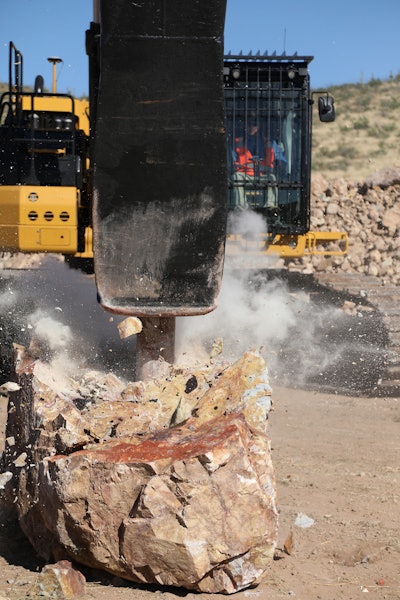 Hone your sense for the change in vibration and sound when material fractures and get off the hydraulic system quickly to minimize blank firing the hammer.Caterpillar Inc.
Hone your sense for the change in vibration and sound when material fractures and get off the hydraulic system quickly to minimize blank firing the hammer.Caterpillar Inc.
2. Don’t Fire Blanks
Anytime you lift the breaker off the surface to be broken, disengage the hydraulics. It requires a little skill. Hammer operators should hone their sense for the change in vibration and sound when material fractures and their reaction speed quickly getting off the hydraulic system to minimize blank firing or dry firing. Some is inevitable, but firing the hammer when the tool is not pressed onto something to be broken delivers 100% of the piston’s energy to the tool steel, which transfers it into the breaker’s bushing and housing.
Even when the tool is in contact with work surface, there’s a no-man’s land short of adequate down pressure on the breaker. When positioning the breaker, the operator should use the boom to transfer some of the carrier’s weight straight down onto the tool, just until the front end of the machine’s tracks begin to lift off the ground. Without enough down pressure, the breaker could bounce around and much of the piston’s force will reflect up into the carrier, risking damage to the breaker’s suspension and the machine boom.
Too much down pressure, and the carrier is lifted too high. When the material breaks, the carrier crashing down risks damage all around.
3. No Prying
Prying with a breaker’s tool point can bend or break the tool, and it can misalign the tool steel in its bushing. Sometimes that misalignment is permanent, but even when it’s only temporary, the potential for expensive damage to the breaker is great. If the piston doesn’t make solid contact with the head of the tool steel as designed, breaking productivity drops off and lateral forces of the impact can damage the piston and/or the cylinder. That can be the most expensive repair a breaker will ever need.
The piston and cylinder are like a hydraulic valve in that wherever they interface it’s close-tolerance, mirror-finished surfaces lubricated by hydraulic oil. Controlled impact at extreme force exceeds the valve metaphor and makes proper alignment crucial when the breaker is working.
Even inadvertently applying lateral pressure on the tool when preloading feed force can wear piston tolerances, which erodes hitting power and adds heat to the carrier’s hydraulic system. Bad habits, such as tying a sling to the breaker to carry loads or pushing around material with the breaker can damage the attachment.
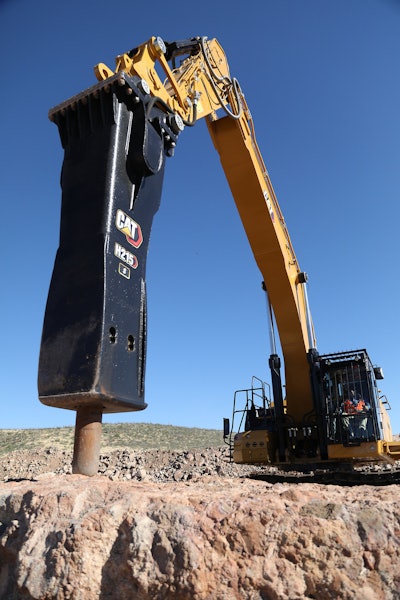 Operators need to get good at looking for cracks they can take advantage of, particularly near the edges of objects they’re trying to break.Caterpillar
Operators need to get good at looking for cracks they can take advantage of, particularly near the edges of objects they’re trying to break.Caterpillar
4. Match Hammer to Carrier
Precision tolerances in the breaker’s piston make any kind of contamination a dangerous enemy. The cleanliness imperative demands care when swapping attachments on site.
When exchanging a bucket for a breaker, make sure the hydraulic hoses are properly capped to keep dirt and dust out of the fittings. Quick-disconnect couplers are a common cause of unexpected hammer failure. Contaminant that can accumulate in a bare fitting can be, with just a few repeated attachment swaps, enough to damage the breaker and the carrier’s hydraulic seals and valves. Use the attachment change to inspect hydraulic hoses and couplers, and keep a clean rag handy to wipe fittings.
If you’re sharing the breaker between carriers, make sure all the carriers are properly sized for the tool, and the hydraulic performance of each potential base machine is matched to the hammer’s needs. It’s a good idea to mark the breaker’s coupler with the model number of the carrier machine or machines it matches. Work with your equipment supplier to confirm that the breaker matches the carrier’s service weight and hydraulic output, as well as the application.
Using a hydraulic breaker that is too small for the carrier machine can damage mounting adapters, the working tool and even the hammer components because the heavier carrier applies too much force.
A properly-sized carrier transmits breaker energy to the work surface to effectively break material. Fitting a carrier with a breaker that’s too large, even if it is capable of lifting the attachment and remaining stable on the work site, subjects the machine to the breaker’s excess impact energy. Breaking power to the target material diminishes, and wear on the carrier boom and hydraulic system accelerates.
Hammers are designed to run within a defined range of hydraulic flow and pressure. The carrier’s flow rate and pressure relief setting are the two main concerns. Flow rate determines the speed at which the hammer hits. Plugged into excess flow, a breaker meeting material that’s slow to break will bounce. Overspeed impacts are very hard on the breaker’s components and structures, and reverberations rebound into the carrier to wear pins, bushings and control arms, and possibly crack the stick or boom.
If the carrier’s relief setting is too low, the breaker won't get enough operating pressure before oil flows over the relief valve, creating excess hydraulic heat. Ineffective breaking power will also cause damaging heat to build up in the working steel.
5. Greasing is Part of Operating
Hydraulic breakers need lots of high-quality grease, typically every two hours but that can vary depending on operating conditions. Grease’s equally important roles are to reduce friction between the working tool and its bushing and carrying dust and debris out of bushing as it melts down the tool.
Standard grease will not do. Breaker makers recommend high-moly grease with a working temperature above 500° F. Molybdenum tends to bond to the bushing and tool steel for persistent lubrication after the oil additives break down and allow the grease to flush debris down the tool.
Some manufacturers recommend using a more-viscous chisel paste for staying power in the heat and vibration of the bushing. Some contain particles of copper and graphite that roll up like ball bearings between the steel and bushing to prevent metal-on-metal contact.
The right amount of grease is just as important as the right type. The two-hour intervals is just a rule of thumb, and it’s not enough for the biggest breakers. There should be enough grease to keep the tool-bushing area filled and to minimize friction.
Proper technique gets grease into the right spots. The carrier should be holding the breaker vertically with enough down pressure on the tool bit to push it up against the strike piston. This forces grease around the tool and into the gaps between it and the bushing. It keeps lube out of the percussion chamber, where the piston strikes the top of the tool. Grease in the percussion chamber on impact can be forced up into the breaker where it can damage the hammer’s seals.
Too little grease allows the bushings to overheat and seize. Shiny marks on the tool are a good indication the breaker isn’t properly lubricated. The actual amount of grease needed for proper lubrication varies according to hammer size, wear rate of the tool shank and bushing, condition of the tool seal, operator’s work techniques and grease quality. Just as the type of grease differs from model to model and manufacturer to manufacturer, so does the ideal amount. It’s best to ask your equipment supplier about the best way to lubricate breakers in your working conditions.
Many makers recommend pumping grease into the breaker bushing until you see grease exiting the bottom of the bushing. It ensures the void between the bushings and the tool steel is filled and displaces old grease new. Grease more often in dry, dusty environments, if the tool looks dry, drags in the bushing or shiny wear spots are rubbed on its shank. The idea is to have grease always flowing down the tool—not running like oil but melting easily and carrying away dirt and debris.
In many applications, you simply cannot supply enough grease by hand to keep a breaker in the 3,000 ft. lb. and larger classes lubricated. That’s where auto-lube systems come into play. Properly maintained auto-lube systems will constantly provide shots of grease into breakers. But don’t let them lull you into complacency. The operator should watch for the signs of a properly-lubed hammer, and they should manually check the grease cartridge or supply lines from the carrier’s auto-lube every two hours.
Wet and underwater applications require more grease because the lube gets washed away. There are biodegradable lubes that will be necessary for open water applications.
Any time a breaker is to be used while submerged, it must be set up with an underwater kit and an air compressor. Without the accessories, water will be sucked into the breaker and contaminate the carrier's hydraulic system with component-ruining consequences.





